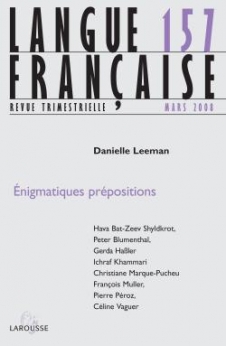
Langue française n° 157 (1/2008)
Pour acheter ce numéro, contactez-nous
Recevez les numéros de l'année en cours et accédez à l'intégralité des articles en ligne.
The reputation of “empty” prepositions such as à and de is based most notably on their behaviour, which is related to that of clitics (Vendryes 1921) or affixes (Miller 1992). From a semantic point of view, their empty, random nature is revealed in the fact that they can be interpreted in contradictory ways, for example in syntactical structures that are associated with transfer predicates. However, in the wake of Cadiot (1993) and Bartning (1996), the hypothesis concerning N1 de N2 constructions has been put forward that it is possible to discern “prototypical relations” when à or de is governed by a linguistic element (verb or adjective). The present study shows that the difference between à and de bears meaning and that the way in which they may or must be distributed relies on a semantic link between the linguistic element that governs the preposition and the preposition itself, following the principle of naturality, which indissolubly associates form and meaning. The difference emerges clearly in pairs where à and de are involved.

